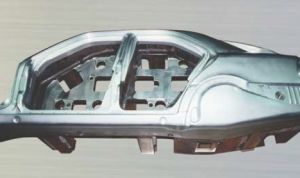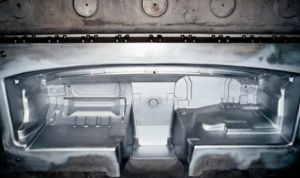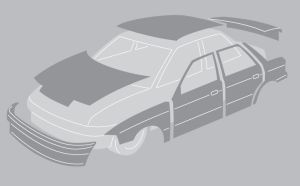The ATC Armoloy coating plays a major role in many areas of the automotive industry, e.g. high-performance tools, forming tools, drawing tools, pressing tools, moulding tools and injection moulding tools. The following examples drawn from practical experience show the many uses the coating has in the field of manufacturing:
ATC Armoloy coating solves problems in exceptional circumstances
Problem
 A drawing tool used for the inner door was designed to process blanks that were zinc coated on one side and protected by foil on the other. But the parts tended to rupture, and abrasion and cold welding were major problems. Even though 15 points were lubricated, the planned number of units and the required quality could not be achieved.
A drawing tool used for the inner door was designed to process blanks that were zinc coated on one side and protected by foil on the other. But the parts tended to rupture, and abrasion and cold welding were major problems. Even though 15 points were lubricated, the planned number of units and the required quality could not be achieved.
Solution
ATC Armoloy was the most efficient solution in this case. At the customer‘s request, the upper half of the tool was ATC Armoloy coated. The problems disappeared and the rejection and reworking rate dropped to approx. 0.2%.
Extending the service life of tools
Problem
The use of an older tool for the manufacture of frontal coverings was to be extended for another 18 months for a specific model. But the components produced with this tool had a very high rejection rate. Major investment was not considered worthwhile because of the foreseeable introduction of a new model.
Solution
ATC Armoloy offers a cost-efficient solution to many problems. The intended coating was discussed and planned, and the tool was technically prepared in a joint effort between the customer‘s tool making engineers and staff from ATC Armoloy. After the preparatory work had been carried out, all relevant components of the tool were ATC Armoloy coated and polished.
ATC Armoloy coating in aluminium processing
Problem
 A hardened drawing tool was being used to manufacture engine bonnets (engine hoods) from aluminium. The tool had to be serviced frequently, and the components produced with it had an extremely high rejection and reworking rate; production quantities were also much lower than planned.
A hardened drawing tool was being used to manufacture engine bonnets (engine hoods) from aluminium. The tool had to be serviced frequently, and the components produced with it had an extremely high rejection and reworking rate; production quantities were also much lower than planned.
Solution
The situation was discussed with ATC Armoloy. The tool-making department of the press plant then improved the relevant surfaces before they were ATC Armoloy coated. The surfaces underwent the normal process that results in a coating thickness of 10 μm. The tool was subsequently polished. During a try-out phase, the tool was started up in order to determine any changes in drawing behaviour, and to make adjustments accordingly. After this phase was completed, the tool was deployed in production. Cold welding, constriction, scratches and abrasion were a thing of the past.
“Dry blanks” coated with ATC Armoloy lead to greatly improved drawability due to reduced friction
Problem
In spite of lubrication, a nitrided tool used for sheet metal intended for the manufacture of wheel housings produced high rates of rework and rejection.
Solution
Coating the nitrided tool with ATC Armoloy coating got rid of the weak spots and enabled the tool to process “dry” blanks coated with rolling-mill oil, thereby achieving a high and steady quality for the parts. The use of ATC Armoloy also produced a huge reduction in costs.
Coating thick sheet metal with ATC Armoloy within the automotive industry
Problem
Within the automotive industry, problems often occur in the production of hinge reinforcements from coldrolled sheet metal of great thickness. Although the tool had been nitrided in this case, many problems to do with abrasion, cracking and cold welding persisted. Despite additional lubrication, the tool had to be taken out of service in order to be serviced and polished after producing 700 to 800 pieces out of a production run of 3,000 pieces. A conventional chromium coating with a coating thickness of between 25 and 40 μm, which is the usual solution to be had on the market, was applied, but it did not adhere properly to the nitrided surface and most of it was destroyed after just a few production parts had been produced.
Solution
First, the remaining bits of the old coating had to be removed before the ATC Armoloy chromium coating could be applied. An Armoloy hardness of 72 HRC (1200 HV) was used. As a result, the drawing ratios improved due to significantly reduced friction; and the tool now exhibited the typical anti-adhesive behaviour of ATC Armoloy. All this led to a significant improvement in parts quality and production flow. There was no more rupturing of the sheet metal, and no more cold welding or abrasion. After the ATC Armoloy coating had been applied, the tool merely had to be inspected after it had produced between 9,000 and 10,000 pieces, and polished as required.
In many areas of aluminium processing, ATC Armoloy coating has greatly improved the production behaviour of problematic surfaces and considerably lengthened their life; as a consequence, tools have a much longer service life than before. And because an ATC Armoloy coating may be applied repeatedly to surfaces, the durability of tools is significantly increased, which in turn leads to big savings on expenditure.
 Further potential for cost-saving may be derived from the continuous high quality of parts and also from a reduction in the amount of drawing additives used and their subsequent disposal. In most cases, the costs incurred for the coating were very soon offset by the reduction in costs. The ATC Armoloy coating adheres so strongly to any bright metal surface used in tool making that even plastic deformation or a wide temperature spread seldom lead to problems. The anti-adhesive behaviour of the ATC Armoloy coating is extremely effective in avoiding cold welding and particle uptake of coated surfaces. The customer will benefit from continuous high production quality and from clean tools that need a minimum of maintenance.
Further potential for cost-saving may be derived from the continuous high quality of parts and also from a reduction in the amount of drawing additives used and their subsequent disposal. In most cases, the costs incurred for the coating were very soon offset by the reduction in costs. The ATC Armoloy coating adheres so strongly to any bright metal surface used in tool making that even plastic deformation or a wide temperature spread seldom lead to problems. The anti-adhesive behaviour of the ATC Armoloy coating is extremely effective in avoiding cold welding and particle uptake of coated surfaces. The customer will benefit from continuous high production quality and from clean tools that need a minimum of maintenance.
The coating is of uniform thickness everywhere, regardless of whether the coated parts are plungers, dies, blank holders, segmented drawing brackets, flanging dies, flanging tools or cutting tools. Experience has shown that the best possible coating thickness for drawing tools, deep drawing tools and pressing tools is 10 μm. With coats of this thickness, the danger of edge build-up, changes in geometry, or a rupture due to stress can largely be ruled out if the base material is flawless. There will also be no need for reworking measures. ATC Armoloy Technology Coatings has collaborated successfully with the automotive industry on many occasions. Our bath has a size of 4.40 by 2.20 metres (approx. 14.4 by 7.2 feet), which enables us to coat tools up to a weight of around 20 tonnes. In the past, we have used ATC coating to coat tools that manufacture dash supports, frontal coverings, bumpers, covers, wind deflectors, wheel housings, door trim panels, engine bonnets (engine hoods), and roofs. Practically all European car factories as well as their component suppliers and tool makers work in close cooperation with ATC, in order to solve a whole range of problems.



